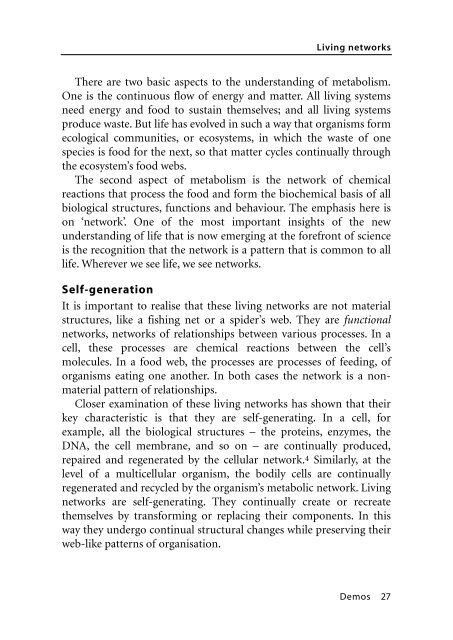Network Logic - Index of
Network Logic - Index of
Network Logic - Index of
You also want an ePaper? Increase the reach of your titles
YUMPU automatically turns print PDFs into web optimized ePapers that Google loves.
Living networks<br />
There are two basic aspects to the understanding <strong>of</strong> metabolism.<br />
One is the continuous flow <strong>of</strong> energy and matter. All living systems<br />
need energy and food to sustain themselves; and all living systems<br />
produce waste. But life has evolved in such a way that organisms form<br />
ecological communities, or ecosystems, in which the waste <strong>of</strong> one<br />
species is food for the next, so that matter cycles continually through<br />
the ecosystem’s food webs.<br />
The second aspect <strong>of</strong> metabolism is the network <strong>of</strong> chemical<br />
reactions that process the food and form the biochemical basis <strong>of</strong> all<br />
biological structures, functions and behaviour. The emphasis here is<br />
on ‘network’. One <strong>of</strong> the most important insights <strong>of</strong> the new<br />
understanding <strong>of</strong> life that is now emerging at the forefront <strong>of</strong> science<br />
is the recognition that the network is a pattern that is common to all<br />
life. Wherever we see life, we see networks.<br />
Self-generation<br />
It is important to realise that these living networks are not material<br />
structures, like a fishing net or a spider’s web. They are functional<br />
networks, networks <strong>of</strong> relationships between various processes. In a<br />
cell, these processes are chemical reactions between the cell’s<br />
molecules. In a food web, the processes are processes <strong>of</strong> feeding, <strong>of</strong><br />
organisms eating one another. In both cases the network is a nonmaterial<br />
pattern <strong>of</strong> relationships.<br />
Closer examination <strong>of</strong> these living networks has shown that their<br />
key characteristic is that they are self-generating. In a cell, for<br />
example, all the biological structures – the proteins, enzymes, the<br />
DNA, the cell membrane, and so on – are continually produced,<br />
repaired and regenerated by the cellular network. 4 Similarly, at the<br />
level <strong>of</strong> a multicellular organism, the bodily cells are continually<br />
regenerated and recycled by the organism’s metabolic network. Living<br />
networks are self-generating. They continually create or recreate<br />
themselves by transforming or replacing their components. In this<br />
way they undergo continual structural changes while preserving their<br />
web-like patterns <strong>of</strong> organisation.<br />
Demos 27
















